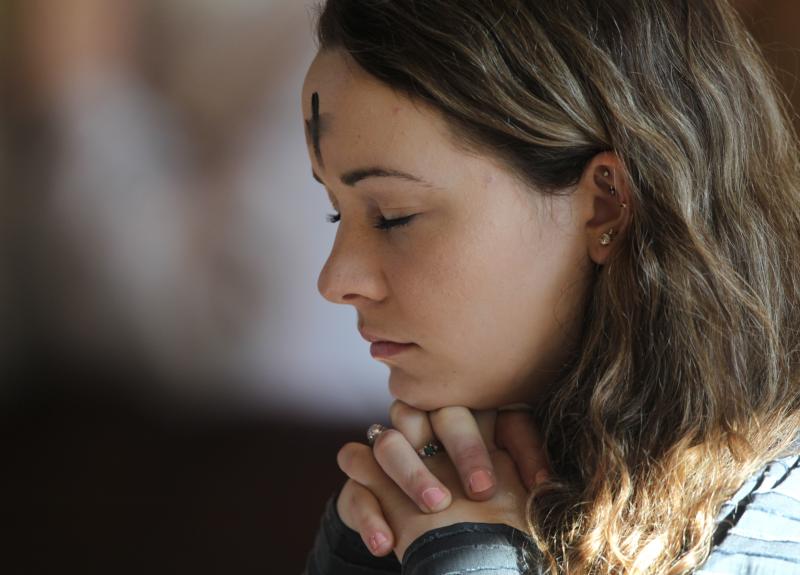 Last year, my 6-year-old son came home from school on Ash Wednesday with the faint mark of ashes on his forehead. Like me, he often rubs his head while thinking during the day, so, also like me, his ashes had faded a lot since the morning Mass. I leaned down to show him my mark as well. He stared in wonder at my forehead and said “Mom, we match!” I could almost see his mind and heart making the connection that he and I had something deep in common. “Yes, we match!” I said as I hugged him close. “Did you know that Ash Wednesday is one of mommy’s favorite days in the church?”
Last year, my 6-year-old son came home from school on Ash Wednesday with the faint mark of ashes on his forehead. Like me, he often rubs his head while thinking during the day, so, also like me, his ashes had faded a lot since the morning Mass. I leaned down to show him my mark as well. He stared in wonder at my forehead and said “Mom, we match!” I could almost see his mind and heart making the connection that he and I had something deep in common. “Yes, we match!” I said as I hugged him close. “Did you know that Ash Wednesday is one of mommy’s favorite days in the church?”
Believe it or not, it is true. It was not my favorite day when I was his age, however.
I remember when I was a child, Ash Wednesday marked the start of whatever Lenten sacrifice I planned to do. I would go to my Catholic grade school on that day already lamenting the absence of candy from my daily diet (that was my go-to sacrifice at the time). And then, I would receive the ashes on my forehead. This was fine during school, but I would get self conscious after school if we had to stop anywhere on the way home. After all, what was supposed to be the shape of a cross had morphed into an odd-shaped smudge by the time 3:00 p.m. rolled around.
RELATED: Lent in the Season of Little Ones
This outlook changed when I grew up, became the director of campus ministry at a Catholic high school, and organizing the Ash Wednesday liturgy became a part of my job. As I planned for the Extraordinary Ministers of Holy Communion and lectors and ash distributors, I started to learn even more about the day itself.
When I was a child, I thought Ash Wednesday was just something that Catholics did. I assumed when I saw ashes on another person’s forehead, they must be Catholic just like me. I learned as an adult, however, that there was no denominational requirement to receive ashes — anyone could receive them as a sign of their faith in Christ. Once I realized this was true, I started to see how the ashes on my forehead united me with other people, and not just Catholics. The smudge on my forehead that sometimes did and sometimes did not look like a cross reminded me that in our rich diversity we also had something universally in common — our humanity.
LISTEN: Why Do We Wear Ashes if the Gospel Says Not to Put Our Faith on Display?
I began to notice others with ashes on their foreheads more, both in person and on social media. Each time I scrolled to see a picture of someone displaying their ashes or ran into another person with ashes at the grocery store, I thought the same words my son had said aloud to me — “We match.”
When we go to Mass as Catholics, we consume the Body and Blood of Christ, and the hope is that we take Christ with us as we leave the church and share Christ with others through our thoughts, words, and actions. On Ash Wednesday, however, we leave the church with a very physical sign of our faith. A dirty, messy, often unrecognizable sign of our humanity. We are, for a day, imperfect. We are, for a day, marked. We are, for a day, visibly human.
RELATED: Why Ash Wednesday Isn’t a Downer
As a day that begins our journey through the Paschal path of Christ, we are also united in this messy humanity, and mortality, with our Savior. The cross of ashes on our foreheads reminds us that he was human, too. It reminds us that he died, just as one day we’ll die, too.
And, if we let it, the ashes we receive on Ash Wednesday can also remind us that we will one day be reunited with him in heaven. Our bodies to dust, but our souls to eternal life in Him.
Let Ash Wednesday this year be a day when you look at someone else and think “we match.” Let Ash Wednesday this year be a day when you recognize the humanity in another person and let them recognize the humanity in you.
Don’t you think that would make you like Ash Wednesday just a little bit more?